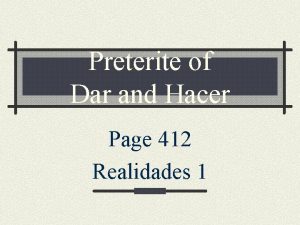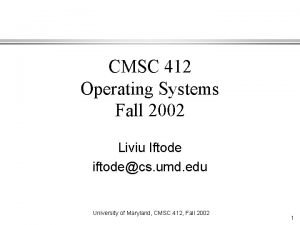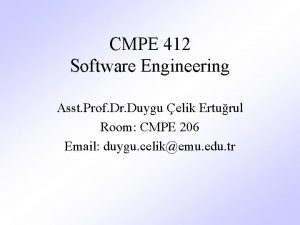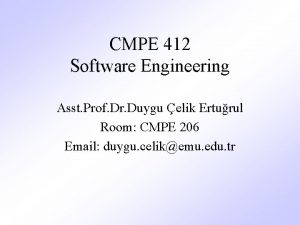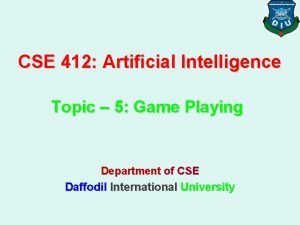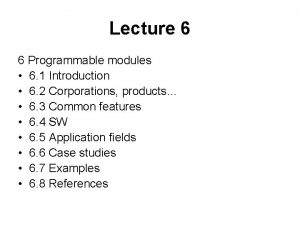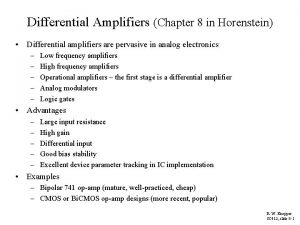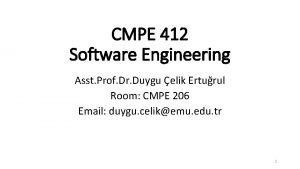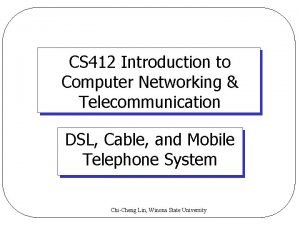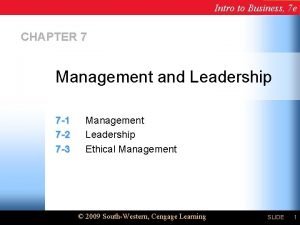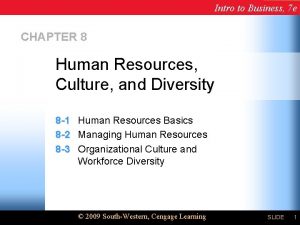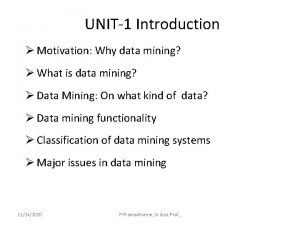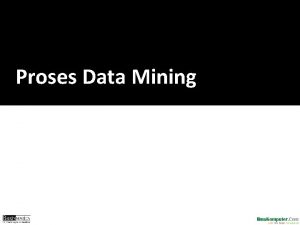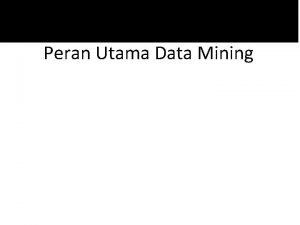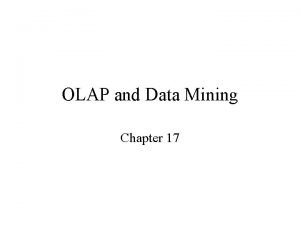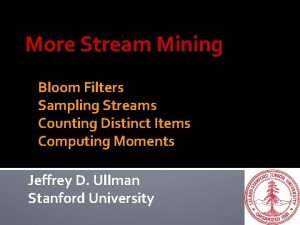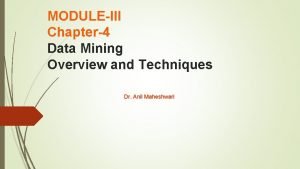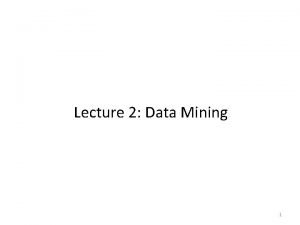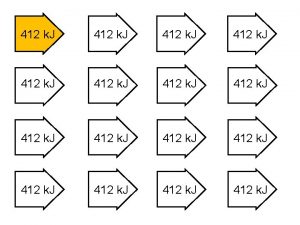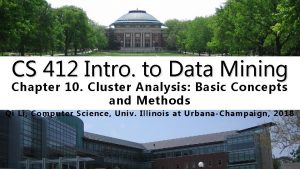CS 412 Intro to Data Mining Chapter 6


































































- Slides: 66

CS 412 Intro. to Data Mining Chapter 6. Mining Frequent Patterns, Association and Correlations: Basic Concepts and Methods Qi Li, Computer Science, Univ. Illinois at Urbana-Champaign, 201 9 1

Chapter 6: Mining Frequent Patterns, Association and Correlations: Basic Concepts and Methods q Basic Concepts q Efficient Pattern Mining Methods q Pattern Evaluation q Summary 2

Pattern Discovery: Basic Concepts 3 q What Is Pattern Discovery? Why Is It Important? q Basic Concepts: Frequent Patterns and Association Rules q Compressed Representation: Closed Patterns and Max-Patterns

What are Patterns? What are patterns? q Patterns: A set of items, subsequences, or substructures that occur frequently together (or strongly correlated) in a data set q Patterns represent intrinsic and important properties of datasets q Frequent item set 4 Frequent sequences Frequent structures

What Is Pattern Discovery? Pattern discovery: Uncovering patterns from massive data sets q It can answer questions such as: q What products were often purchased together? q What are the subsequent purchases after buying an i. Pad? q 5

Pattern Discovery: Why Is It Important? Foundation for many essential data mining tasks q Association, correlation, and causality analysis q Mining sequential, structural (e. g. , sub-graph) patterns q Classification: Discriminative pattern-based analysis q Cluster analysis: Pattern-based subspace clustering q Broad applications q Market basket analysis, cross-marketing, catalog design, sale campaign analysis, Web log analysis, biological sequence analysis q Many types of data: spatiotemporal, multimedia, time-series, and stream data q 6

Basic Concepts: Transactional Database (TDB) q Each transaction is associated with an identifier, called a TID. q May also have counts associated with each item sold q 7 Tid Items bought 1 Beer, Nuts, Diaper 2 Beer, Coffee, Diaper 3 Beer, Diaper, Eggs 4 Nuts, Eggs, Milk 5 Nuts, Coffee, Diaper, Eggs, Milk

Basic Concepts: k-Itemsets and Their Supports q Itemset: A set of one or more items Tid Items bought 1 Beer, Nuts, Diaper 2 Beer, Coffee, Diaper 3 Beer, Diaper, Eggs 4 Nuts, Eggs, Milk 5 Nuts, Coffee, Diaper, Eggs, Milk k-itemset: An itemset containing k items: X = {x 1, …, xk} q Ex. {Beer, Nuts, Diaper} is a 3 -itemset q Absolute support (count) q sup{X} = occurrences of an itemset X q Ex. sup{Beer} = 3 q Ex. sup{Diaper} = 4 q Ex. sup{Beer, Diaper} = 3 q Ex. sup{Beer, Eggs} = 1 q 8 Relative support q s{X} = The fraction of transactions that contains X (i. e. , the probability that a transaction contains X) q Ex. s{Beer} = 3/5 = 60% q Ex. s{Diaper} = 4/5 = 80% q Ex. s{Beer, Eggs} = 1/5 = 20% q

Basic Concepts: Frequent Itemsets (Patterns) An itemset (or a pattern) X is frequent if the support of X is no less than a minsup threshold σ q q Let σ = 50% (σ: minsup threshold) for the given 5 -transaction dataset All the frequent 1 -itemsets: q Beer: 3/5 (60%); Nuts: 3/5 (60%); Diaper: 4/5 (80%); Eggs: 3/5 (60%) q All the frequent 2 -itemsets: q {Beer, Diaper}: 3/5 (60%) q All the frequent 3 -itemsets? q None q 9 Tid Items bought 1 Beer, Nuts, Diaper 2 Beer, Coffee, Diaper 3 Beer, Diaper, Eggs 4 Nuts, Eggs, Milk 5 Nuts, Coffee, Diaper, Eggs, Milk q Why do these itemsets (shown on the left) form the complete set of frequent k-itemsets (patterns) for any k? q Observation: We may need an efficient method to mine a complete set of frequent patterns

From Frequent Itemsets to Association Rules Compared with itemsets, association rules can be more telling q Ex. Diaper Beer q Buying diapers may likely lead to buying beers q Containing both Beer {Beer} {Diaper} Containing diaper Diaper Containing beer {Beer} {Diaper} = {Beer, Diaper} 10 Note: X Y: the union of two itemsets n The set contains both X and Y

Association Rules How do we compute the strength of an association rule X Y (Both X and Y are itemsets)? q We first compute the following two metrics, s and c. q Support of X Y q Ex. s{Diaper, Beer} = 3/5 = 0. 6 (i. e. , 60%) q Confidence of X Y q The conditional probability that a transaction containing X also contains Y: c = sup(X, Y) / sup(X) q Ex. c = sup{Diaper, Beer}/sup{Diaper} = ¾ = 0. 75 q 11 Tid Items bought 1 Beer, Nuts, Diaper 2 Beer, Coffee, Diaper 3 Beer, Diaper, Eggs 4 Nuts, Eggs, Milk 5 Nuts, Coffee, Diaper, Eggs, Milk q In pattern analysis, we are often interested in those rules that dominate the database, and these two metrics ensure the popularity and correlation of X and Y.

Mining Frequent Itemsets and Association Rules Association rule mining q Given two thresholds: minsup, minconf q Find all of the rules, X Y (s, c) such that s ≥ minsup and c ≥ minconf q q Let minsup = 50% q Freq. 1 -itemsets: Beer: 3, Nuts: 3, Diaper: 4, Eggs: 3 q Freq. 2 -itemsets: {Beer, Diaper}: 3 Let minconf = 50% q Beer Diaper (60%, 100%) q Diaper Beer (60%, 75%) q 12 (Q: Are these all rules? ) Tid Items bought 1 Beer, Nuts, Diaper 2 Beer, Coffee, Diaper 3 Beer, Diaper, Eggs 4 Nuts, Eggs, Milk 5 Nuts, Coffee, Diaper, Eggs, Milk Observations: q Mining association rules and mining frequent patterns are very close problems q Scalable methods are needed for mining large datasets q

Challenge: There Are Too Many Frequent Patterns! A long pattern contains a combinatorial number of sub-patterns q How many frequent itemsets does the following TDB 1 contain (minsup = 1)? q TDB 1: T 1: {a 1, …, a 50}; T 2: {a 1, …, a 100} q Let’s have a try 1 -itemsets: {a 1}: 2, {a 2}: 2, …, {a 50}: 2, {a 51}: 1, …, {a 100}: 1, 2 -itemsets: {a 1, a 2}: 2, …, {a 1, a 50}: 2, {a 1, a 51}: 1 …, …, {a 99, a 100}: 1, …, … 99 -itemsets: {a 1, a 2, …, a 99}: 1, …, {a 2, a 3, …, a 100}: 1 100 -itemset: {a 1, a 2, …, a 100}: 1 A too huge set for any q The total number of frequent itemsets: one to compute or store! q 13

Expressing Patterns in Compressed Form How to reduce the redundancy of the list of all the frequent itemsets? q If {a 1, …, a 99} and {a 1, …, a 100} have the same support in the database, then we don't need to list both of them q Solution 1: Closed patterns: A pattern (itemset) X is closed if X is frequent, and there exists no super-pattern Y כ X, with the same support as X q q Ex. TDB 1: T 1: {a 1, …, a 50}; T 2: {a 1, …, a 100} q Suppose minsup = 1. How many closed patterns does TDB 1 contain? q 14 Two: P 1: “{a 1, …, a 50}: 2”; P 2: “{a 1, …, a 100}: 1”

Expressing Patterns in Compressed Form: Closed Patterns q 15 Closed pattern is a lossless compression of frequent patterns q Reduces the # of patterns but does not lose the support information! q Given P 1: “{a 1, …, a 50}: 2”; P 2: “{a 1, …, a 100}: 1” q You will still be able to say: “{a 2, …, a 40}: 2”, “{a 5, a 51}: 1”

Expressing Patterns in Compressed Form: Max-Patterns q Solution 2: Max-patterns: A pattern X is a max-pattern if X is frequent and there exists no frequent super-pattern Y כ X q Difference from close-patterns? q Do not care the real support of the sub-patterns of a max-pattern Let Transaction DB TDB 1: T 1: {a 1, …, a 50}; T 2: {a 1, …, a 100} q Suppose minsup = 1. How many max-patterns does TDB 1 contain? q q 16 One: P: “{a 1, …, a 100}: 1”

Expressing Patterns in Compressed Form: Max. Patterns Max-pattern is a lossy compression! q We only know a subset of the max-pattern P, {a 1, …, a 40} , is frequent q But we do not know the real support of {a 1, …, a 40}, …, any more! q Thus in many applications, mining closed-patterns is more desirable than mining max-patterns q 17

Chapter 6: Mining Frequent Patterns, Association and Correlations: Basic Concepts and Methods q Basic Concepts q Efficient Pattern Mining Methods q Pattern Evaluation q Summary 18

Efficient Pattern Mining Methods q 19 The Downward Closure Property of Frequent Patterns q The Apriori Algorithm q Extensions or Improvements of Apriori q Mining Frequent Patterns by Exploring Vertical Data Format q FPGrowth: A Frequent Pattern-Growth Approach q Mining Closed Patterns

The Downward Closure Property of Frequent Patterns Frequent itemset: {a 1, …, a 50} q Subsets are all frequent: {a 1}, {a 2}, …, {a 50}, {a 1, a 2}, …, {a 1, …, a 49}, … q Downward closure (Apriori): Any subset of a frequent itemset must be frequent q If {beer, diaper, nuts} is frequent, so is {beer, diaper} q If any subset of an itemset S is infrequent, then there is no chance for S to be frequent. A sharp knife for pruning! q 20

Apriori Pruning and Scalable Mining Methods Apriori pruning principle: If there is any itemset which is infrequent, its superset should not even be generated! (Agrawal & Srikant @VLDB’ 94, Mannila, et al. @ KDD’ 94) q Scalable mining Methods: Three major approaches q Level-wise, join-based approach: Apriori (Agrawal & Srikant@VLDB’ 94) q Vertical data format approach: Eclat (Zaki, Parthasarathy, Ogihara, Li @KDD’ 97) q Frequent pattern projection and growth: FPgrowth (Han, Pei, Yin @SIGMOD’ 00) q 21

Apriori: A Candidate Generation & Test Approach Outline of Apriori (level-wise, candidate generation and test) q 22 q Scan DB once to get frequent 1 -itemset q Repeat q Generate length-(k+1) candidate itemsets from length-k frequent itemsets q Test the candidates against DB to find frequent (k+1)-itemsets q Set k : = k +1 q Until no frequent or candidate set can be generated q Return all the frequent itemsets derived

The Apriori Algorithm (Pseudo-Code) Ck: Candidate itemset of size k Fk : Frequent itemset of size k K : = 1; Fk : = {frequent items}; // frequent 1 -itemset While (Fk != ) do { // when Fk is non-empty Ck+1 : = candidates generated from Fk; // candidate generation Derive Fk+1 by counting candidates in Ck+1 with respect to TDB at minsup; k : = k + 1 } return k Fk // return Fk generated at each level 23

The Apriori Algorithm—An Example Database TDB Tid Items 10 A, C, D 20 B, C, E 30 A, B, C, E 40 B, E minsup = 2 C 1 1 st scan C 2 F 2 Itemset {A, C} {B, E} {C, E} C 3 24 Itemset {B, C, E} sup 2 2 3 2 Itemset sup {A} 2 {B} 3 {C} 3 {D} 1 {E} 3 Itemset {A, B} {A, C} {A, E} {B, C} {B, E} {C, E} 3 rd scan sup 1 2 3 2 F 3 F 1 Itemset sup {A} 2 {B} 3 {C} 3 {E} 3 C 2 Itemset {A, B} 2 nd scan {A, C} {A, E} {B, C} {B, E} {C, E} Itemset sup {B, C, E} 2

Apriori: Implementation Tricks How to generate candidates? q q Step 1: self-joining Fk q Step 2: pruning abc Example of candidate-generation q q F 3 = {abc, abd, ace, bcd} q Self-joining: F 3*F 3 q abcd from abc and abd q acde from acd and ace q q q 25 self-join Pruning: acde is removed because ade is not in F 3 C 4 = {abcd} abd abcd self-join acd ace acde pruned bcd

Candidate Generation (Pseudo-Code) Suppose the items in Fk-1 are listed in an order self-join q // Step 1: Joining zabc zabd ace bcd for each p in Fk-1 zabcd acde for each q in Fk-1 if p. item 1= q. item 1, …, p. itemk-2 = q. itemk-2, p. itemk-1 < q. itemk-1 { c = join(p, q) q // Step 2: pruning if has_infrequent_subset(c, Fk-1) continue // prune else add c to Ck } q 26

Apriori: Improvements and Alternatives Reduce passes of transaction database scans To be discussed in q Partitioning (e. g. , Savasere, et al. , 1995) subsequent slides q Dynamic itemset counting (Brin, et al. , 1997) q Shrink the number of candidates To be discussed in q Hashing (e. g. , DHP: Park, et al. , 1995) subsequent slides q Pruning by support lower bounding (e. g. , Bayardo 1998) q Sampling (e. g. , Toivonen, 1996) q Exploring special data structures q Tree projection (Agarwal, et al. , 2001) q H-miner (Pei, et al. , 2001) q Hypecube decomposition (e. g. , LCM: Uno, et al. , 2004) q 27

Partitioning: Scan Database Only Twice q Theorem: Any itemset that is potentially frequent in TDB must be frequent in at least one of the partitions of TDB Here is the p roof! + TDB 1 sup 1(X) < σ|TDB 1| 28 TDB 2 + sup 2(X) < σ|TDB 2| . . . + TDBk supk(X) < σ|TDBk| = TDB sup(X) < σ|TDB|

Partitioning: Scan Database Only Twice Method: Scan DB twice (A. Savasere, E. Omiecinski and S. Navathe, VLDB’ 95) q Scan 1: Partition database so that each partition can fit in main memory (why? ) q Mine local frequent patterns in this partition q Scan 2: Consolidate global frequent patterns q Find global frequent itemset candidates (those frequent in at least one partition) q Find the true frequency of those candidates, by scanning TDB i one more time q 29

Direct Hashing and Pruning (DHP) Hashing: v = hash(itemset) q 1 st scan: When counting the 1 -itemset, hash 2 itemset to calculate the bucket count q Example: At the 1 st scan of TDB, count 1 -itemset, and hash 2 -itemsets in the transaction to its bucket q {ab, ad, ce} q {bd, be, de} q … q At the end of the first scan, q if minsup = 80, remove ab, ad, ce, since count{ab, ad, ce} < 80 q 30 V might be same for different itemset Itemsets Count {ab, ad, ce} 35 {bd, be, de} 298 …… … {yz, qs, wt} 58 Hash Table Check the minsup

Exploring Vertical Data Format: ECLAT q 31 ECLAT (Equivalence Class Transformation): A depth-first search algorithm using set intersection [Zaki et al. @KDD’ 97] A transaction DB in Horizontal Data Format Tid Itemset q Vertical format 10 a, c, d, e q Properties of Tid-Lists 20 a, b, e 30 b, c, e q t(X) = t(Y): X and Y always happen together (e. g. , t(ac} = t(d}) q t(X) t(Y): transaction having X always has Y (e. g. , t(ac) t(ce)) q Frequent patterns: vertical intersections q Using diffset to accelerate mining The transaction DB in Vertical Data Format t(e) = {T 10, T 20, T 30}; t(a) = {T 10, T 20}; t(ae) = {T 10, T 20} q Only keep track of differences of tids q t(e) = {T 10, T 20, T 30}, t(ce) = {T 10, T 30} → Diffset (ce, e) = {T 20} Item Tid. List a 10, 20 b 20, 30 c 10, 30 d 10 e 10, 20, 30

Why Mining Frequent Patterns by Pattern Growth? q 32 Apriori: A breadth-first search mining algorithm q First find the complete set of frequent k-itemsets q Then derive frequent (k+1)-itemset candidates q Scan DB again to find true frequent (k+1)-itemsets

Why Mining Frequent Patterns by Pattern Growth? q q Can we develop a depth-first search mining algorithm? q For a frequent itemset ρ, can subsequent search be confined to only those transactions that containing ρ? q q 33 Motivation for a different mining methodology Such thinking leads to a frequent pattern growth approach: FPGrowth (J. Han, J. Pei, Y. Yin, “Mining Frequent Patterns without Candidate Generation, ” SIGMOD 2000)

Prerequisite: Find frequent 1 -itemset TID Items in the Transaction 100 {f, a, c, d, g, i, m, p} 200 {a, b, c, f, l, m, o} 300 {b, f, h, j, o, w} 400 {b, c, k, s, p} 500 {a, f, c, e, l, p, m, n} 1. Scan DB once, find single item frequent Let min_support = 3 pattern: f: 4, a: 3, c: 4, b: 3, m: 3, p: 3 2. Sort frequent items frequency descending F-list =inf-c-a-b-m-p order, f-list 34

Example: Construct FP-tree from a Transaction DB TID Items in the Transaction Ordered, frequent itemlist 100 {f, a, c, d, g, i, m, p} f, c, a, m, p 200 {a, b, c, f, l, m, o} f, c, a, b, m 300 {b, f, h, j, o, w} f, b 400 {b, c, k, s, p} c, b, p 500 {a, f, c, e, l, p, m, n} f, c, a, m, p 3. Scan DB again, find the ordered frequent itemlist for each transaction 35

Example: Construct FP-tree from a Transaction DB TID Items in the Transaction Ordered, frequent itemlist 100 {f, a, c, d, g, i, m, p} f, c, a, m, p 200 {a, b, c, f, l, m, o} f, c, a, b, m 300 {b, f, h, j, o, w} f, b 400 {b, c, k, s, p} c, b, p 500 {a, f, c, e, l, p, m, n} f, c, a, m, p 4. For each transaction, insert the ordered frequent itemlist into an FP-tree, with shared sub-branches merged, counts accumulated 36 After inserting the 1 st frequent Itemlist: “f, c, a, m, p” {} Header Table Item Frequency f 4 c 4 a 3 b 3 m 3 p 3 header f: 1 c: 1 a: 1 m: 1 p: 1

Example: Construct FP-tree from a Transaction DB TID Items in the Transaction Ordered, frequent itemlist 100 {f, a, c, d, g, i, m, p} f, c, a, m, p 200 {a, b, c, f, l, m, o} f, c, a, b, m 300 {b, f, h, j, o, w} f, b 400 {b, c, k, s, p} c, b, p 500 {a, f, c, e, l, p, m, n} f, c, a, m, p 4. For each transaction, insert the ordered frequent itemlist into an FP-tree, with shared subbranches merged, counts accumulated 37 After inserting the 2 nd frequent itemlist “f, c, a, b, m” {} Header Table Item Frequency f 4 c 4 a 3 b 3 m 3 p 3 f: 2 header c: 2 a: 2 m: 1 b: 1 p: 1 m: 1

Example: Construct FP-tree from a Transaction DB TID Items in the Transaction Ordered, frequent itemlist 100 {f, a, c, d, g, i, m, p} f, c, a, m, p 200 {a, b, c, f, l, m, o} {} f, c, a, b, m 300 {b, f, h, j, o, w} f, b 400 {b, c, k, s, p} c, b, p 500 {a, f, c, e, l, p, m, n} f, c, a, m, p 4. For each transaction, insert the ordered frequent itemlist into an FP-tree, with shared subbranches merged, counts accumulated 38 After inserting all the frequent itemlists Header Table Item Frequency f 4 c 4 a 3 b 3 m 3 p 3 f: 4 header c: 3 c: 1 b: 1 a: 3 b: 1 p: 1 m: 2 b: 1 p: 2 m: 1

Mining FP-Tree: Divide and Conquer Based on Patterns and Data q Pattern mining can be partitioned according to current patterns q We start to calculate the conditional database from bottom to top (from the least frequent item) q Conditional database: the database under the condition that p exists q p’s conditional database (Patterns containing p): fcam: 2, cb: 1 {} Conditional database of each pattern min_support = 3 39 Item Frequency f 4 c 4 a 3 b 3 m 3 p 3 f: 4 Header c: 3 c: 1 b: 1 a: 3 b: 1 p: 1 m: 2 b: 1 p: 2 m: 1 Item Conditional database p fcam: 2, cb: 1

Mining FP-Tree: Divide and Conquer Based on Patterns and Data q q p’s conditional database (Patterns containing p): fcam: 2, cb: 1 After calculating p’s conditional database, we calculate m’s conditional database {} Conditional database of each pattern min_support = 3 40 Item Frequency f 4 c 4 a 3 b 3 m 3 p 3 f: 4 Header c: 3 c: 1 b: 1 a: 3 b: 1 p: 1 m: 2 b: 1 p: 2 m: 1 Item Conditional database m fca: 2, fcab: 1 p fcam: 2, cb: 1

Mining FP-Tree: Divide and Conquer Based on Patterns and Data q q Repeat and calculate the conditional database of b, a, and c Since f is the most frequent item, we don’t need to compute its conditional dataset {} Conditional database of each pattern min_support = 3 41 Item Frequency f 4 c 4 a 3 b 3 m 3 p 3 f: 4 Header c: 3 c: 1 b: 1 a: 3 b: 1 p: 1 m: 2 b: 1 p: 2 m: 1 Item Conditional database c f: 3 a fc: 3 b fca: 1, f: 1, c: 1 m fca: 2, fcab: 1 p fcam: 2, cb: 1

Mine Each Conditional Database Recursively min_support = 3 Conditional Data Bases item cond. data base c f: 3 a fc: 3 b fca: 1, f: 1, c: 1 For each conditional database q Mine single-item patterns q Construct its FP-tree & mine it q e. g. , mining m’s FP-tree {} {} {} m fca: 2, fcab: 1 f: 3 p c: 3 cm’s FP-tree cam’s FP-tree fcam: 2, cb: 1 a: 3 m’s FP-tree 42 {} am’s FP-tree Actually, for single branch FP-tree, all the frequent patterns can be generated in one shot m: 3 fm: 3, cm: 3, am: 3 fcm: 3, fam: 3, cam: 3 fcam: 3

A Special Case: Single Prefix Path in FP-tree q Suppose a (conditional) FP-tree T has a shared single prefix-path P q Mining can be decomposed into two parts {} q Reduction of the single prefix path into one node a 1: n 1 q Concatenation of the mining results of the two parts a 2: n 2 a 3: n 3 c 1: k 1 b 1: m 1 r 1 = a 1: n 1 a 2: n 2 a 3: n 3 c 2: k 2 43 r 1 {} c 3: k 3 + c 1: k 1 b 1: m 1 c 2: k 2 c 3: k 3

FPGrowth: Mining Frequent Patterns by Pattern Growth q 44 Essence of frequent pattern growth (FPGrowth) methodology q Find frequent single items and partition the databased on each such single item pattern q Recursively grow frequent patterns by doing the above for each partitioned database (also called the pattern’s conditional database) q To facilitate efficient processing, an efficient data structure, FP-tree, can be constructed

FPGrowth: Mining Frequent Patterns by Pattern Growth q 45 Mining becomes q Recursively construct and mine (conditional) FP-trees q Until the resulting FP-tree is empty, or until it contains only one path— single path will generate all the combinations of its sub-paths, each of which is a frequent pattern

Scaling FP-growth by Item-Based Data Projection What if FP-tree cannot fit in memory? —Do not construct FP-tree q “Project” the databased on frequent single items q Construct & mine FP-tree for each projected DB q Parallel projection vs. partition projection q Parallel projection: Project the DB on each frequent item q Space costly, all partitions can be processed in parallel q Partition projection: Partition the DB in order q Passing the unprocessed parts to subsequent partitions q Trans. DB Parallel projection f 4 -proj. DB f 2 f 3 f 4 g h f 3 f 4 i j f 2 f 4 k f 1 f 3 h 46 … Assume only f’s are frequent & the frequent item ordering is: f 1 -f 2 -f 3 -f 4 f 3 -proj. DB f 2 f 3 f 1 f 2 … … Partition projection f 4 -proj. DB f 3 -proj. DB f 2 f 3 f 1 f 3 … f 2 will be projected to f 3 -proj. DB only when processing f 4 proj. DB …

CLOSET+: Mining Closed Itemsets by Pattern. Growth a 1: n 1 a 2: n 1 a 3: n 1 c 1: k 1 b 1: m 1 c 2: k 2 47 Efficient, direct mining of closed itemsets q Intuition: q If an FP-tree contains a single branch as shown left q “a 1, a 2, a 3” should be merged q Itemset merging: If Y appears in every occurrence of X, then Y is merged with X q d-proj. db: {acef, acf} → acfd-proj. db: {e} q Final closed itemset: acfd: 2 q There are many other tricks developed q For details, see J. Wang, et al, , “CLOSET+: Searching for the Best Strategies for Mining Frequent Closed Itemsets”, KDD'03 q {} c 3: k 3 TID Items 1 acdef 2 abe 3 cefg 4 acdf Let minsupport = 2 a: 3, c: 3, d: 2, e: 3, f: 3 F-List: a-c-e-f-d

Chapter 6: Mining Frequent Patterns, Association and Correlations: Basic Concepts and Methods q Basic Concepts q Efficient Pattern Mining Methods q Pattern Evaluation q Summary 48

Pattern Evaluation 49 q Limitation of the Support-Confidence Framework q Interestingness Measures: Lift and χ2 q Null-Invariant Measures q Comparison of Interestingness Measures

How to Judge if a Rule/Pattern Is Interesting? q Pattern-mining will generate a large set of patterns/rules q q Not all the generated patterns/rules are interesting Interestingness measures: Objective vs. subjective q Objective interestingness measures q q Support, confidence, correlation, … Subjective interestingness measures: q Different users may judge interestingness differently q Let a user specify q Query-based: q Relevant to a user’s particular request Judge against one’s knowledge-base q unexpected, freshness, timeliness 50

Limitation of the Support-Confidence Framework q Are s and c interesting in association rules: “A B” [s, c]? Be careful! q Example: Suppose one school may have the following statistics on # of students who may play basketball and/or eat cereal: q sum (row) eat-cereal 400 350 750 not eat-cereal 200 50 250 sum(col. ) 600 400 1000 2 -way play-basketball eat-cereal [40%, 66. 7%] (higher s & c) But this strong association rule is misleading: The overall % of students eating cereal is 75% > 66. 7%, a more telling rule: q 51 not play-basketball Association rule mining may generate the following: q q play-basketball ¬ play-basketball eat-cereal [35%, 87. 5%] (high s & c) contin gency table

Interestingness Measure: Lift q Measure of dependent/correlated events: lift Lift(B, C) may tell how B and C are correlated q Lift(B, C) = 1: B and C are independent q > 1: positively correlated q < 1: negatively correlated q For our example, q Thus, B and C are negatively correlated since lift(B, C) < 1; q B and ¬C are positively correlated since lift(B, ¬C) > 1 q 52 Lift is more telling than s & c B ¬B ∑row C 400 350 750 ¬C 200 50 250 ∑col. 600 400 1000

Interestingness Measure: χ2 q q Another measure to test correlated events: χ2 For the table on the right, B ¬B ∑row C 400 (450) 350 (300) 750 ¬C 200 (150) 50 (100) 250 ∑col 600 400 1000 Expected value 53 Observed value q Lookup χ2 distribution table => B, C are correlated q χ2 -test shows B and C are negatively correlated since the expected value is 450 but the observed is only 400 q Thus, χ2 is also more telling than the support-confidence framework

Lift and χ2 : Are They Always Good Measures? q Null transactions: Transactions that contain neither B nor C q Let’s examine the new dataset D q ∑row C 1000 1100 ¬C 100000 101000 ∑col. 1100 101000 102100 null transactions Unlikely B & C will happen together! Contingency table with expected values added B ¬B ∑row But, Lift(B, C) = 8. 44 >> 1 (Lift shows B and C are C 100 (11. 85) 1000 1100 ¬C 1000 (988. 15) 100000 101000 strongly positively correlated!) ∑col. 1100 101000 102100 q 54 ¬B BC (100) is much rarer than B¬C (1000) and ¬BC (1000), but there are many ¬B¬C (100000) q B q χ2 = 670: Observed(BC) >> expected value (11. 85) q Too many null transactions may “spoil the soup”!

Interestingness Measures & Null-Invariance Null invariance means: The number of null transactions does not matter. Does not change the measure value. q A few interestingness measures: Some are null invariant q 55

Null Invariance: An Important Property Why is null invariance crucial for the analysis of massive transaction data? q Many transactions may contain neither milk nor coffee! q milk vs. coffee contingency table 56 Lift and 2 are not null-invariant: not good to evaluate data that contain too many or too few null transactions! q Many measures are not null-invariant! q

Comparison of Null-Invariant Measures Not all null-invariant measures are created equal q Which one is better? q D 4—D 6 differentiate the null-invariant measures q Kulc (Kulczynski 1927) holds firm and is in balance of both directional implications q All 5 are null-invariant 57 2 -variable contingency table

Imbalance Ratio with Kulczynski Measure q IR (Imbalance Ratio): measure the imbalance of two itemsets A and B in rule implications: q Kulczynski and Imbalance Ratio (IR) together present a clear picture for all the three datasets D 4 through D 6 D 4 is neutral & balanced; D 5 is neutral but imbalanced q D 6 is neutral but very imbalanced q 58

Example: Analysis of DBLP Coauthor Relationships DBLP: Computer science research publication bibliographic database q > 3. 8 million entries on authors, paper, venue, year, and other information q Advisor-advisee relation: Kulc: high, Jaccard: low, cosine: middle Which pairs of authors are strongly related? Is A the advisor, or the advisee? q Use Kulc to find Advisor-advisee, close collaborators q 59

What Measures to Choose for Effective Pattern Evaluation? Null value cases are predominant in many large datasets q Neither milk nor coffee is in most of the baskets; neither Mike nor Jim is an author in most of the papers; …… q Null-invariance is an important property q Lift, χ2 and cosine are good measures if null transactions are not predominant q Otherwise, Kulczynski + Imbalance Ratio should be used to judge the interestingness of a pattern q 60

What Measures to Choose for Effective Pattern Evaluation? Exercise: Mining research collaborations from research bibliographic data q Find a group of frequent collaborators from research bibliographic data (e. g. , DBLP) q Can you find the likely advisor-advisee relationship and during which years such a relationship happened? q Ref. : C. Wang, J. Han, Y. Jia, J. Tang, D. Zhang, Y. Yu, and J. Guo, "Mining Advisor. Advisee Relationships from Research Publication Networks", KDD'10 q 61

Chapter 6: Mining Frequent Patterns, Association and Correlations: Basic Concepts and Methods q Basic Concepts q Efficient Pattern Mining Methods q Pattern Evaluation q Summary 62

Summary 63 q Basic Concepts q What Is Pattern Discovery? Why Is It Important? q Basic Concepts: Frequent Patterns and Association Rules q Compressed Representation: Closed Patterns and Max-Patterns q Efficient Pattern Mining Methods q The Downward Closure Property of Frequent Patterns q The Apriori Algorithm q Extensions or Improvements of Apriori q Mining Frequent Patterns by Exploring Vertical Data Format q FPGrowth: A Frequent Pattern-Growth Approach q Mining Closed Patterns q Pattern Evaluation q Interestingness Measures in Pattern Mining q Interestingness Measures: Lift and χ2 q Null-Invariant Measures q Comparison of Interestingness Measures

Recommended Readings (Basic Concepts) 64 q R. Agrawal, T. Imielinski, and A. Swami, “Mining association rules between sets of items in large databases”, in Proc. of SIGMOD'93 q R. J. Bayardo, “Efficiently mining long patterns from databases”, in Proc. of SIGMOD'98 q N. Pasquier, Y. Bastide, R. Taouil, and L. Lakhal, “Discovering frequent closed itemsets for association rules”, in Proc. of ICDT'99 q J. Han, H. Cheng, D. Xin, and X. Yan, “Frequent Pattern Mining: Current Status and Future Directions”, Data Mining and Knowledge Discovery, 15(1): 55 -86, 2007

Recommended Readings (Efficient Pattern Mining Methods) q R. Agrawal and R. Srikant, “Fast algorithms for mining association rules”, VLDB'94 q A. Savasere, E. Omiecinski, and S. Navathe, “An efficient algorithm for mining association rules in large databases”, VLDB'95 J. S. Park, M. S. Chen, and P. S. Yu, “An effective hash-based algorithm for mining association rules”, SIGMOD'95 S. Sarawagi, S. Thomas, and R. Agrawal, “Integrating association rule mining with relational database systems: Alternatives and implications”, SIGMOD'98 M. J. Zaki, S. Parthasarathy, M. Ogihara, and W. Li, “Parallel algorithm for discovery of association rules”, Data Mining and Knowledge Discovery, 1997 J. Han, J. Pei, and Y. Yin, “Mining frequent patterns without candidate generation”, SIGMOD’ 00 M. J. Zaki and Hsiao, “CHARM: An Efficient Algorithm for Closed Itemset Mining”, SDM'02 J. Wang, J. Han, and J. Pei, “CLOSET+: Searching for the Best Strategies for Mining Frequent Closed Itemsets”, KDD'03 C. C. Aggarwal, M. A. , Bhuiyan, M. A. Hasan, “Frequent Pattern Mining Algorithms: A Survey”, in Aggarwal and Han (eds. ): Frequent Pattern Mining, Springer, 2014 q q q q 65

Recommended Readings (Pattern Evaluation) 66 q C. C. Aggarwal and P. S. Yu. A New Framework for Itemset Generation. PODS’ 98 q S. Brin, R. Motwani, and C. Silverstein. Beyond market basket: Generalizing association rules to correlations. SIGMOD'97 q M. Klemettinen, H. Mannila, P. Ronkainen, H. Toivonen, and A. I. Verkamo. Finding interesting rules from large sets of discovered association rules. CIKM'94 q E. Omiecinski. Alternative Interest Measures for Mining Associations. TKDE’ 03 q P. -N. Tan, V. Kumar, and J. Srivastava. Selecting the Right Interestingness Measure for Association Patterns. KDD'02 q T. Wu, Y. Chen and J. Han, Re-Examination of Interestingness Measures in Pattern Mining: A Unified Framework, Data Mining and Knowledge Discovery, 21(3): 371 -397, 2010
 Cs 412 introduction to data mining
Cs 412 introduction to data mining Mining complex types of data in data mining
Mining complex types of data in data mining Multimedia data mining
Multimedia data mining Strip mining vs open pit mining
Strip mining vs open pit mining Mineral resources and mining chapter 13
Mineral resources and mining chapter 13 Difference between strip mining and open pit mining
Difference between strip mining and open pit mining Text and web mining
Text and web mining Data reduction in data mining
Data reduction in data mining What is kdd process in data mining
What is kdd process in data mining What is missing data in data mining
What is missing data in data mining Concept hierarchy generation for nominal data
Concept hierarchy generation for nominal data Data reduction in data mining
Data reduction in data mining Data reduction in data mining
Data reduction in data mining Shell cube in data mining
Shell cube in data mining Data reduction in data mining
Data reduction in data mining Arsitektur data mining
Arsitektur data mining Data mining dan data warehouse
Data mining dan data warehouse Data mining dan data warehouse
Data mining dan data warehouse Complex data types in data mining
Complex data types in data mining Olap
Olap Noisy data in data mining
Noisy data in data mining Rolap architecture
Rolap architecture Markku roiha
Markku roiha Data compression in data mining
Data compression in data mining Introduction to data warehousing and data mining
Introduction to data warehousing and data mining Data warehouse dan data mining
Data warehouse dan data mining The preterite of hacer and dar (p. 412)
The preterite of hacer and dar (p. 412) Maria buchert
Maria buchert Resolución 412 de 2000 derogada
Resolución 412 de 2000 derogada Tuntun aku tuhan allah
Tuntun aku tuhan allah Liviu iftode
Liviu iftode Ist 412
Ist 412 Ertugrul 412
Ertugrul 412 Ertugrul 412
Ertugrul 412 Martin jagersand
Martin jagersand Cse 412
Cse 412 412 nutrition
412 nutrition Easy 412-ac-rc
Easy 412-ac-rc Phonak supero 412
Phonak supero 412 P-fet short 412
P-fet short 412 Ertugrul 412
Ertugrul 412 Friday 412
Friday 412 Ekyros com
Ekyros com 5 cfr 412
5 cfr 412 Shoreline school district 412
Shoreline school district 412 Factors of 412
Factors of 412 Cs 412
Cs 412 Chapter 10 marketing answer key
Chapter 10 marketing answer key Chapter 7 study guide management and leadership
Chapter 7 study guide management and leadership Intro to business chapter 8
Intro to business chapter 8 Anaerobic exercise physiology
Anaerobic exercise physiology Chapter 1 intro to forensic science
Chapter 1 intro to forensic science Intro to business chapter 10
Intro to business chapter 10 Unsupervised learning in data mining
Unsupervised learning in data mining Motivation and importance of data mining
Motivation and importance of data mining Data mining concepts and techniques slides
Data mining concepts and techniques slides Reporting and query tools
Reporting and query tools Pump it up data mining the water table
Pump it up data mining the water table Output data mining
Output data mining Algoritma estimasi yang biasa digunakan adalah
Algoritma estimasi yang biasa digunakan adalah Olap stands for: *
Olap stands for: * Bloom filter for stream data mining
Bloom filter for stream data mining What are the steps in mining process?
What are the steps in mining process? Data mining midterm exam with solutions
Data mining midterm exam with solutions Multidimensional space in data mining
Multidimensional space in data mining Data mining roadmap
Data mining roadmap Pentaho data mining
Pentaho data mining


























